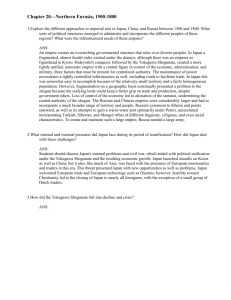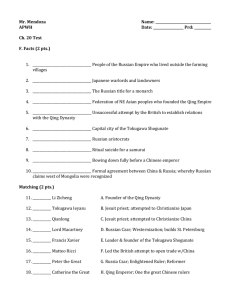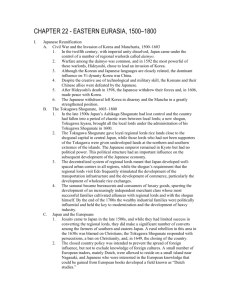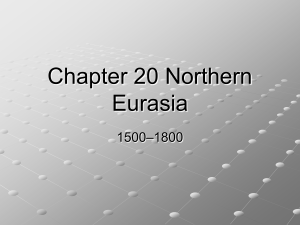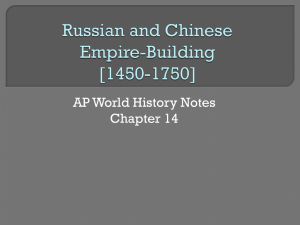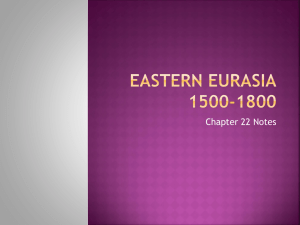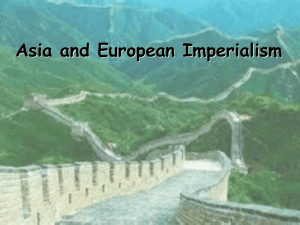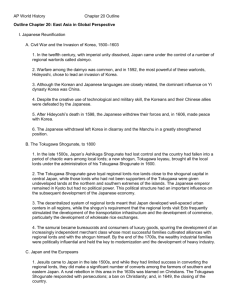Notes: Chapter 20, Northern Eurasia, 1500-1800
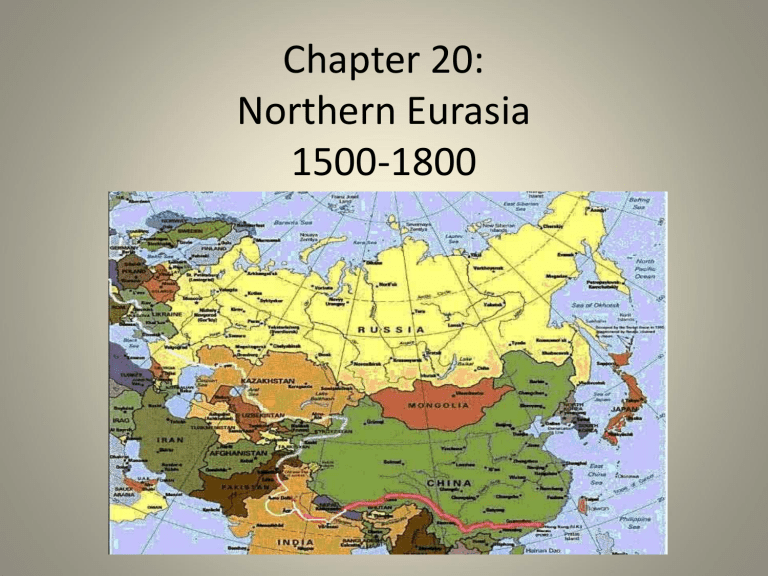
Chapter 20:
Northern Eurasia
1500-1800
Reunification: Civil War & Invasion of Korea,
1500–1603
• In 12 th century, Japan came under control of regional warlords called daimyo
• Warfare among daimyo was common
• Hideyoshi, invaded Korea
• Japanese won
• After Hideyoshi’s death
Japanese withdrew- made peace with Korea
• Korea left in disarray-
Manchu allies strengthened
“Korean Turtle Boats” - the world’s first ironclad warships
Japanese Reunification: Tokugawa Shogunate,
• In late 1500s, Ashikaga Shogunate lost control- civil war broke out
• Tokugawa Ieyasu, brought all local lords under Tokugawa Shogunate in
1600
• TS gave loyal regional lords rice lands close to shogunal capital in central
Japan
• Lords who had not supported
Tokugawa given undeveloped lands north & south extremes of islands
• Emperor remained in Kyoto-no political power
• This political structure had an important influence on subsequent development of Japanese economy
Japanese Reunification: Tokugawa Ieyasu
• Decentralization = urban centers
• “Alternate Attendance”-regional lords required to visit Edo yearly
• Transportation infrastructure & commerce developed
• Samurai became bureaucrats & consumers of luxury goods
• independent merchant class developed
• Successful families cultivated alliances w/ regional lords & shogun
• Wealthy industrial families became politically influential
• Key to modernization & development of heavy industry
Japan & Europeans
Thanks to “Dutch studies” scholars and to overseas contacts, many Japanese were well informed about cultures, technologies
& political systems of various parts of world.
• Jesuits came to Japan in late 1500s
• Converted some regional lords
• Many farmer converts in south & east
• Rural rebellion in 1630s blamed on
Christians
• Persecutions followed; Christianity banned-in 1649-country closed to foreigners
• Meant to prevent foreign influence but not knowledge of foreign cultures
• Dutch, allowed to reside on small island near Nagasaki (Dejima)
• Japanese interested in European knowledge developed field known as “Dutch studies”
• Some of “outer lords” in north & south continued to trade
• Those in south, became wealthy from control of maritime trade
Elite Decline & Social Crisis
• Population & economic growth contributed to reversal of fortunes between inner & outer lords
• Population growth in central
Japan put strain on agricultural economy, but in outer provinces, economic growth outstripped population growth
• Samurai & regional lords became dependent on merchants to give credit
• Decentralization made it difficult to regulate merchants
• Merchants developed influence
& vibrant culture
“The Floating World”
47 Ronin Incident 1701-1703
• Exemplified ideological & social crisis of Tokugawa Japan’s transformation from military to a civil society
• the military (samurai) forced to obey civil law
Later Ming: 1500-1644
• Economic & political problems
– Corruption
– Power-hungry eunuchs
– Costly support of Korea against
Japan
– technology stagnated
• Annual temperatures dropped
– Agricultural distress, migration, disease, and uprisings
– Mongols and Manchus needed to protect land from Ming
• Peasant rebellions
– Taxes/inflation from flow of silver hit rural population hard
• Disorder/inefficiency in urban industrial sector
• no growth in agricultural productivity
• low population growth
Ming Collapse & Rise of Qing
• Rebel forces overthrew Ming in
1644
• Manchu imperial family ruled
Qing Empire
• small proportion of population
• depended on diverse people
Trading Companies & Missionaries
• Europeans eager to trade w/ China
• Imperial court reluctant
• Over 16th c., Portuguese, Spanish,
& Dutch gained limited access to
Chinese trade
• By 17th c., Dutch East India
Company major European trader in
Indian Ocean
• Catholic missionaries, Portuguese
& Spanish traders, Jesuits successful converting some
Chinese elites
• Jesuit Matteo Ricci (1552–1610) used mastery of Chinese language
& culture to gain access to imperial court
Porcelain with Dutch East India Co. Logo
Emperor Kangxi:
(r. 1662–1722)
• Took control at age of 16 (executed chief regent)
• Intellectual prodigy & military commander
• Expanded territory, provided stability
• Incorporated ideas/ technology from
Mongolian, Tibetan, Korean, & Chinese
• Adapted European knowledge & technology—mapmaking, astronomy, & anatomical & pharmaceutical knowledge—taught by Jesuits
• Jesuits adapted to Chinese
– Revised religious teaching to allow
Chinese converts to practice
Confucian ancestor worship
• transmitted Chinese technology
– early form of inoculation against smallpox
– management techniques of the huge imperial porcelain factories
Chinese Influences on Europe
• Exchange of ideas & information flowed in both directions
• Wealth & power of Qing led to enthusiasm in
Europe for Chinese things such as:
• silk, tea, porcelain, other decorative items,
& wallpaper
• Voltaire saw Qing emperors as benevolent despots- philosopherkings- Europeans could learn from them
Great Pagoda at Kew Gardens: Complete in 1762
Tea & Diplomacy
• Qing wanted to control trade w/ Europe
• Created Canton Trade
System
• British believed China’s markets held potential for unlimited profit
• British Parliament worried about flow of British silver into China-imbalance
• Sought to open China’s markets
• British sent Lord Macartney to open diplomatic ties & revise trade system
• Macartney mission failed
• Dutch, French, Russian missions failed too
Population & Social Stress
• Population Explosion:
– Peace enforced by Qing
– Agricultural productivity
– American/ African crops
• Increased environmental stress:
– deforestation
– erosion
– silting up of river channels & canals
– flooding
• Caused migration, crime, rebellions
• Territory & population of Qing
Empire increased- officials did not
• Qing unable to:
– enforce tax regulations
– control standards for entry into government service
– prevent declining revenue
– Reduce corruption
– Prevent banditry in late 1700s
The Russian Empire: Drive Across Northern Asia
• Moscow absorbed former Kievan state-Novgorod in west- conquered khanates of Kazan Astrakhan
• Muscovite ruler Ivan IV took title of tsar in 1547
• Russia expanded east & into
Siberia- led by armed adventurers who defeated only political power in region- Khanate of Sibir- took land from native people
• Siberia valued for furs/timber & penal colony
• In 1650s, expanding Russian Empire met expanding Qing Empire in
Mongolia, Central Asia, & along the
Amur
• Treaty in 1689 recognized Russian claims west of Mongolia
Russian Society & Politics to 1725
• Diverse peoples, cultures, religions produced tensions
• Cossacks made temp alliances w/ whoever could pay them
• important role for Russian Empiremaintained autonomy
• Threats/ invasions by Sweden &
Poland & internal disputes among
Russian aristocracy (boyars) in 17th c. led to overthrow of Muscovite rulers-
• Mikhail Romanov took control in 1613
• Romanov rulers consolidated authority & expanded east
• As power of Romanov rose, freedom of Russian peasants fell
• In 1649, Russian peasants legally transformed into serfs
Peter the Great:
(r.1689-1725)
• Unsuccessfully fought Ottomans for warm-water port on Black Sea & to liberate Istanbul from Muslim rule
• Broke Swedish control over Balticestablished direct contacts between
Russia & Europe in Great North War
• Built St. Petersburg, westernized Russian elites-demonstrated sophistication of
Russia
• New capital intended to break power of
boyars-reduced traditional roles in government & army
• Wanted to use European technology & culture to strengthen Russia & to strengthen his autocratic power
• Not interested in political liberalization
• As an autocratic ruler:
• Controlled Russian Orthodox Church
• built industrial plants to serve military
• Increased taxes & labor on serfs
Westernization
• Pushed Russian elites to imitate European fashions:
• Shaved beards
• Ended traditional seclusion of upper-class women
• Required officials, military officers, merchants to bring wives to social events
• Directed nobles to education their children
St. Petersburg: A Modern City
Consolidation of the Empire
• Russian expansion in Alaska &
American northwest was driven by search for furs competition w/ British &
American entrepreneurs
• Control of Siberia’s natural resources helped Russia dominate fur & shipping industries of North Pacific
• During reign of Catherine the
Great (r. 1762–1796), Russia was world’s largest land empire, built on economic basis of large territory, agriculture, logging, fishing, & furs
Political Comparisons
• Between 1500 & 1800, China & Russia grew dramatically, both in territory controlled & population
• Despite being headed by an emperor, Japan’s size, homogeneity, & failure to add colonies disqualify it from being called a true empire
• Japan & Russia made greater progress in improving their military than did China
• Of Japan, Russia, & China, Russia did most to build up its imperial navy
Cultural, Social, & Economic Comparisons
• As they expanded, both China & Russia pursued policies that tolerated diversity while promoting cultural assimilation
• While both Russian & Chinese leaders were willing to use foreign ideas & technologies, they tended to see their own culture as superior
• Merchants occupied a precarious position in both
China and Japan
Discussion Questions:
• What did the Russian and Qing Empires have in common, and how did these common features affect the relationship between the two?
• How and why did the role of the Jesuits as transmitters of
European ideas differ in Russia, China, and Japan?
• What role did foreign trade play in the economy of the Qing
Empire?
• How and why did Peter the Great’s attitude toward the west differ from that of Kangxi?
• Both the Qing and the Tokugawa governments were in decline by 1800. What reasons lay behind the decline of each government?
• How did the political structure of the Tokugawa Shogunate influence the economic development of early modern
Japan?
